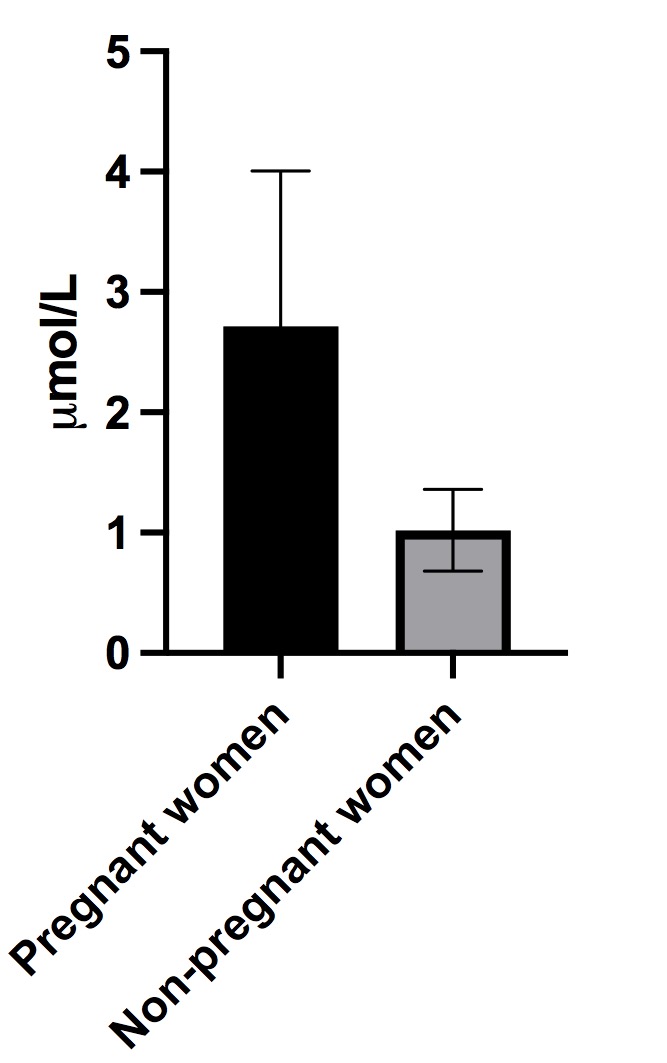Estimation of malondialdehyde and catalase activity in pregnant women at IIMS&R Hospital, Lucknow, India
Abstract
Background: During pregnancy, the physiological production of reactive oxygen species (ROS) is associated with a variety of maternal, placental, and fetal developmental functions. These functions are disrupted by excessive amounts of ROS, resulting to pregnancy complications. Different stages of pregnancy require a balance between oxidant and antioxidant production.
Objective: The aim of this study is to investigate the status of malondialdehyde (MDA) and catalase (CAT) activity in pregnant and age matched non-pregnant women.
Methods: In this cross-sectional study, a total of 74 participants were enrolled, including 37 pregnant and 37 age-matched non-pregnant women. The age range of participants was 18 to 40 years. MDA and CAT levels were measured spectrophotometrically. A p-value 0.05 was statistically significant.
Results: Compared to non-pregnant women, the mean plasma level of MDA was considerably elevated in pregnant women (p<0.0001). However, the mean level of CAT activity in pregnant women was significantly lower than in non-pregnant women (p<0.0001) In pregnant women, there is a significant strong negative correlation between MDA levels and CAT activity (p<0.01).
Conclusion: Pregnant women have high level of oxidative stress, indicating that the pregnant women are more susceptible to oxidative damage and may develop pregnancy-associated complications.
References
Geller PA. Pregnancy as a stressful life event. CNS Spectr. 2004;9: 188-197. https://doi.org/10.1017/S1092852900008981
Duhig K, Chappell LC, Shennan AH. Oxidative stress in pregnancy and reproduction. Obstet Med. 2016;9: 113-116. https://doi.org/10.1177/1753495X16648495
Mutinati M, Pantaleo M, Roncetti M, Piccinno M, Rizzo A, Sciorsci RL. Oxidative stress in neonatology: A review. Reprod Domest Anim. 2014;49: 7-16. https://doi.org/10.1111/rda.12230
Casanueva E, Viteri FE. Iron and oxidative stress in pregnancy. J Nutr. 2003;133: 1700-1708. https://doi.org/10.1093/jn/133.5.1700S
Jones DP. Forum Review: Redefining Oxidative Stress. Antioxidants Redox Signal. 2006;8. https://doi.org/10.1089/ars.2006.8.1865
Hussain T, Murtaza G, Metwally E, Kalhoro DH, Kalhoro MS, Rahu BA, et al. The Role of Oxidative Stress and Antioxidant Balance in Pregnancy. Mediators Inflamm. 2021;2021. https://doi.org/10.1155/2021/9962860
Hajam YA, Rani R, Ganie SY, Sheikh TA, Javaid D, Qadri SS, et al. Oxidative Stress in Human Pathology and Aging: Molecular Mechanisms and Perspectives. Cells. 2022;11. https://doi.org/10.3390/cells11030552
Goyal MM, Basak A. Human catalase: Looking for complete identity. Protein Cell. 2010;1: 888-897. https://doi.org/10.1007/s13238-010-0113-z
Sharma P, Prabha Singh S, Kumar P, Sharma R. Estimation of malondialdehyde and catalase in pregnant & non-prenant women. Santosh Univ J Heal Sci. 2020;6: 21-25. https://doi.org/10.18231/j.sujhs.2020.006
Díaz A, Loewen PC, Fita I, Carpena X. Thirty years of heme catalases structural biology. Arch Biochem Biophys. 2012;525: 102-110. https://doi.org/10.1016/j.abb.2011.12.011
Tylavsky FA, Han L, Sims Taylor LM, Alex Mason W, Carroll KN, Bush NR, et al. Oxidative Balance Score during Pregnancy Is Associated with Oxidative Stress in the CANDLE Study. Nutrients. 2022;14: 1-11. https://doi.org/10.3390/nu14112327
Mohammad TDKM, Shehreen A, Renu G, Priyanka MT. A Comparative Study Of Oxidative Status In Pregnant And Non-Pregnant. Indian J Basic Appl Med Res. 2016;5: 225-230.
Weltärztebund. WMA Deklaration von Helsinki -Ethische Grundsätze für die medizinische Forschung am Menschen. WMA-Generalversammlung. 2013;35: 1-10.
Sinha AK. Colorimetric assay of catalase. Anal Biochem. 1972;47: 389-394. https://doi.org/10.1016/0003-2697(72)90132-7
Adiga US, Adiga MNS. Total antioxidant activity in normal pregnancy. Online J Heal Allied Sci. 2009;8: 1-4.
Zhang Y, Wang J, Gong X, Chen L, Zhang B, Wang Q, et al. Ambient PM2.5 exposures and systemic biomarkers of lipid peroxidation and total antioxidant capacity in early pregnancy. Environ Pollut. 2020; 266: 115301. https://doi.org/10.1016/j.envpol.2020.115301
Shekhawat P, Bennett MJ, Sadovsky Y, Nelson DM, Rakheja D, Strauss AW. Human placenta metabolizes fatty acids: Implications for fetal fatty acid oxidation disorders and maternal liver diseases. Am J Physiol - Endocrinol Metab. 2003;284: 1098-1105. https://doi.org/10.1152/ajpendo.00481.2002
Toboła-Wróbel K, Pietryga M, Dydowicz P, Napierała M, Brązert J, Florek E. Association of Oxidative Stress on Pregnancy. Oxid Med Cell Longev. 2020;2020. https://doi.org/10.1155/2020/6398520
Jadhav SS, Tiwari P, Lata K, Tyagi E, Shete P, Rakh JA, et al. Iron Deficiency Anaemia & Ferrum Phosphoricum: A Systematic Review. Int J Res Rev. 2019;6: 83-91. Available: www.ijrrjournal.com
Coler BS, Shynlova O, Boros-Rausch A, Lye S, McCartney S, Leimert KB, et al. Landscape of preterm birth therapeutics and a path forward. J Clin Med. 2021;10: 1-34. https://doi.org/10.3390/jcm10132912
Aoyama T, Li D, Bay JL. Weight Gain and Nutrition during Pregnancy: An Analysis of Clinical Practice Guidelines in the Asia-Pacific Region. Nutrients. 2022;14: 1-16. https://doi.org/10.3390/nu14061288
Coffey D. Prepregnancy body mass and weight gain during pregnancy in India and sub-Saharan Africa. Proc Natl Acad Sci U S A. 2015;112: 3302-3307. https://doi.org/10.1073/pnas.1416964112

Copyright (c) 2022 Authors

This work is licensed under a Creative Commons Attribution-NonCommercial 4.0 International License.







